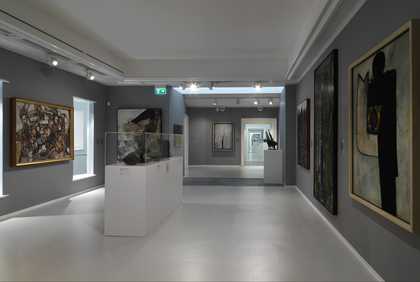This room considers how modern artists working in St Ives re-engaged with Europe and North America
Some artists were exploring the visual effects of painting, while others invested meaning in their improvised use of materials.
British painter, writer and critic Patrick Heron was central to this connection in both his writing and painting. He championed the importance of early modern painters in Paris such as Georges Braque who had redefined relationships of colour and space in painting. He also promoted younger artists such as British painters Roger Hilton, Keith Vaughan and French artist Nicolas de Staël who expanded these ideas in their work.
Many artists in post-war Britain, Europe and North America developed styles that sought to express contemporary philosophies about human experience. Throughout the 1950s various institutional shows in London, Paris and New York showcased artists whose work stripped back representations of the human form, notably French artist Jean Dubuffet and Dutch artist Karel Appel. A new generation of British sculptors including Kenneth Armitage also captured this mood in their creature-like, dark bronze forms.
During this period important international festivals such as the Venice and São Paulo biennials in Italy and Brazil began to establish a new international community of modern artists. Curators and critics, including Patrick Heron who was a correspondent for the New York magazine, Arts (NY), debated new trends and ideas across continents. By the end of the decade Peter Lanyon, Sandra Blow, Alan Davie and Roger Hilton had exhibited in Europe and America and Barbara Hepworth and Ben Nicholson were established as leading British artists.
Tate St Ives

